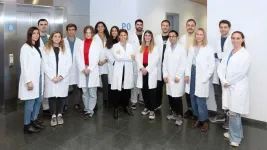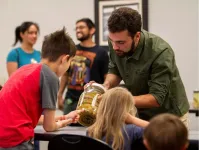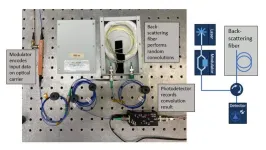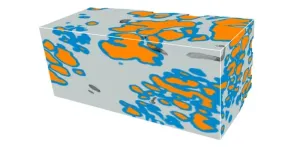(Press-News.org) In a new study published in Proceedings of the National Academy of Sciences (PNAS), researchers from the University of Minnesota Medical School investigated brain development to understand how different areas of the brain become specialized in handling information such as vision, sound, touch and planning.
The study found that different areas of the brain start with a similar organization rather than already being specialized in early development. This suggests that the brain might use a single shared blueprint to guide early development.
“Throughout life, the brain continually builds on the foundations set earlier in development. This strong similarity in early development across very different areas of the brain suggests that neurodevelopmental disorders — such as autism or schizophrenia, which affect many different parts of the nervous system — may act similarly across these different brain areas,” said Gordon Smith, Ph.D., assistant professor at the U of M Medical School and principal investigator on the study. Dr. Smith is also a member of the Medical Discovery Team on Optical Imaging and Brain Science.
In collaboration with the Frankfurt Institute of Advanced Studies, the research team used advanced optical imaging techniques to measure spontaneous activity in diverse brain areas. They found that even in different parts of the brain — such as those responsible for hearing, seeing and feeling touch — as well as in areas linked to thinking in both the front and back part of the brain, the activity in networks of brain cells showed a very similar organization during early development. Researchers discovered that nerve cells in these areas work together in small, synchronized groups. These groups are part of bigger networks that cover millimeters in each part of the brain.
“This type of organization has long been a hallmark of visual brain areas, but finding it in other regions — especially in non-sensory regions like the prefrontal cortex — was a surprise,” said Dr. Smith.
Ongoing research will examine other brain regions at different stages of development to determine how the common blueprint identified in this study changes over time.
Funding for this study was provided by the National Institutes of Health’s National Eye Institute [R01EY030893-01], Whitehall Foundation, National Science Foundation and Germany’s Federal Ministry of Education and Research.
###
About the University of Minnesota Medical School
The University of Minnesota Medical School is at the forefront of learning and discovery, transforming medical care and educating the next generation of physicians. Our graduates and faculty produce high-impact biomedical research and advance the practice of medicine. We acknowledge that the U of M Medical School is located on traditional, ancestral and contemporary lands of the Dakota and the Ojibwe, and scores of other Indigenous people, and we affirm our commitment to tribal communities and their sovereignty as we seek to improve and strengthen our relations with tribal nations. For more information about the U of M Medical School, please visit med.umn.edu.
END
U of M-led study reveals shared blueprint in brain development across different functional areas
2024-03-11
ELSE PRESS RELEASES FROM THIS DATE:
Researchers solve crucial cold-induced sweetening problem in potato production
2024-03-11
Researchers have discovered a game changer for the potato industry.
According to a new study published in a leading international society journal published by the American Society of Plant Biologists, a small genetic element is the cause of a major production problem in potatoes.
“Our manuscript reveals the mystery of “cold-induced sweetening” (CIS), the most troublesome and expensive problem for the potato processing industry,” explained Jiming Jiang, Corresponding Author of “Molecular dissection of an intronic enhancer governing cold-induced expression ...
Developed by VHIO, a novel AI-based and non-invasive diagnostic tool enables accurate brain tumor diagnosis, outperforming current classification methods
2024-03-11
Developed by VHIO, a novel AI-based and non-invasive diagnostic tool enables accurate brain tumor diagnosis, outperforming current classification methods
Developed by VHIO’s Radiomics Group in close collaboration with researchers of the Neuroradiology Unit at the Bellvitge University Hospital (HUB), DISCERN is a deep learning tool that leverages information of magnetic resonance imaging and facilitates brain tumor classification to aid clinical decision making.
Currently, a definitive diagnosis often requires neurosurgical interventions that compromise the quality of life of patients.
Trained to differentiate between the three most ...
Natural history specimens have never been so accessible
2024-03-11
With the help of 16 grants from the National Science Foundation, researchers have painstakingly taken computed topography (CT) scans of more than 13,000 individual specimens to create 3D images of more than half of all the world's animal groups, including mammals, fishes, amphibians and reptiles.
The research team, made of members from The University of Texas at Arlington and 25 other institutions, are now a quarter of the way through inputting nearly 30,000 media files to the open-source repository MorphoSource. This will allow researchers ...
NRL research physicists explore fiber optic computing using distributed feedback
2024-03-11
WASHINGTON – U.S. Naval Research Laboratory (NRL) researchers deliver novel contribution in fiber optics computing, Fiber Optic Computing Using Distributed Feedback paper recently published in Communications Physics journal, brings the Navy one step closer to faster, more efficient computing technologies.
Optical computing uses the properties of light, such as its speed and ability to carry large amounts of data, to process information more efficiently than traditional electronic computers.
In collaboration with Sandia National Laboratories and the University of Central Florida, NRL is aiming ...
Canals used to drain peatlands are underappreciated hotspots for carbon emissions
2024-03-11
A new study led by UC San Diego Scripps Institution of Oceanography postdoctoral scholar Jennifer Bowen finds that canals used to drain soggy peatlands in Southeast Asia are likely hotspots for greenhouse gas emissions.
The results, published March 8 in Nature Geoscience and supported by the Scripps Institutional Postdoctoral Program and Stanford University’s Precourt Institute for Energy, identify a previously unaccounted for source of emissions from these threatened, carbon-rich landscapes. Findings from the study suggest that the degradation of tropical peatlands in Southeast Asia has released even more planet-warming ...
Nutritional value of meat should be considered when comparing carbon footprints
2024-03-11
The nutritional value of meat must be considered when comparing carbon footprints – that is the key message from a recent study undertaken by Hybu Cig Cymru – Meat Promotion Wales (HCC), Bangor University, Queen’s University, and the Agri-Food and Biosciences Institute (AFBI).
The scientific paper, published in the journal Frontiers in Sustainable Food Systems using data from the Welsh Lamb Meat Quality project, focuses on different lamb production systems, specifically the ‘finishing’ period – at the end of which lambs have reached the required weight, meat and fat cover for ...
Microscopy plus deep learning to advance prostate cancer diagnosis
2024-03-11
Prostate cancer stands as a prevalent threat to men's health, ranking second in cancer-related deaths in the United States. Each year, approximately 250,000 men in the U.S. receive a prostate cancer diagnosis. While most cases have low morbidity and mortality rates, a subset of cases demands aggressive treatment. Urologists assess the need for such treatment primarily through the Gleason score, which evaluates prostate gland appearance on histology slides. However, there's considerable variability in interpretation, leading to both undertreatment and overtreatment.
The current method, based on histology ...
Cancer researchers awarded $3.2 million grant to find better ways to treat advanced melanoma
2024-03-11
A team of investigators from the UCLA Health Jonsson Comprehensive Cancer and the University of Arkansas for Medical Sciences (UAMS) Winthrop P. Rockefeller Cancer Institute was awarded a $3.2 million grant from the National Institutes of Health to identify new ways to prevent and overcome treatment resistance to targeted therapy in patients with all sub-types of cutaneous melanoma, an aggressive form of skin cancer.
Virtually all cutaneous melanomas display genetic alterations that ...
The liver immune system eats up ‘bad cholesterol’
2024-03-11
A new study from Karolinska Institutet in Sweden reveals that immune cells in the liver react to high cholesterol levels and eat up excess cholesterol that can otherwise cause damage to arteries. The findings, published in Nature Cardiovascular Research, suggest that the response to the onset of atherosclerosis begins in the liver.
Cholesterol is a type of fat that is essential for many functions in the body, such as making hormones and cell membranes. However, too much cholesterol in the blood can be harmful, as it can stick to the walls of the arteries ...
New study finds female entrepreneurs do better with guidance from female mentors
2024-03-11
INFORMS Journal Marketing Science Study Key Takeaways:
Female entrepreneurs increase their chances of success and improved performance with female mentors.
One of the key benefits to female entrepreneurs is a mentoring style characterized as “positive engagement.”
BALTIMORE, MD, March 11, 2024 – In business and in life, the power of mentorship has long been understood, but how important is it that your mentor look like you? This question was at the center of a new study, which specifically found that mentor gender has a powerful impact on ...




